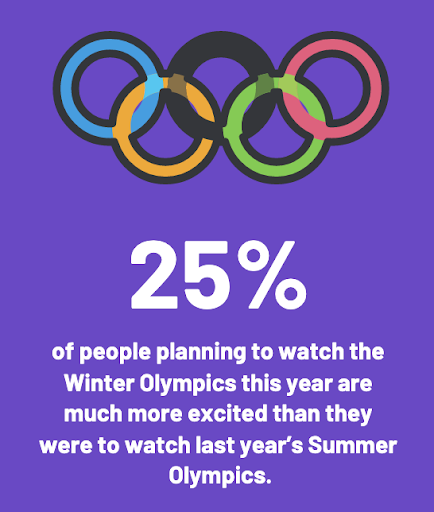Why Brands Cannot Sit Out During This Year’s Winter Sports Extravaganza
Why Brands Cannot Sit Out During This Year’s Winter Sports Extravaganza
• • • • • •
It’s hard to think of any sporting events in our culture larger in spectacle than the Super Bowl or the Olympics. Both are showcases for athletes with big-time talent. They’re also big-time opportunities for brands to showcase themselves, generate awareness, and capitalize on demand.
Ads, Ads, Ads
Brand spending on Super Bowl ads has approached half-a-billion dollars in recent years. For nearly a quarter of the Big Game’s viewers, the commercials are in fact the real attraction.
For brands, Super Bowl ads show the world that you’re a name to know, follow, and trust. An entertaining, effective Super Bowl ad can also earn your brand significant social shares — or even go viral — and increase your social media influence.
The same can be said for ads that air during the Olympics. Revenue from ad sales for the Olympic Games’ broadcasts hovers around $1.25 billion. The commercials themselves are no less cinematic and affecting, than those we see during the NFL’s climactic contest.
Obviously, marketers across industry see the potential in Super Bowl and Olympic ads and devote significant resources to them. If your company has the means, running a commercial during one or both of these events is a no-brainer.
The One-Two Punch In 2022 = Outsized Sales Revenue Opportunity
This year, “the Big Game” and “the Games” are running concurrently. The Olympics stretch from February 2nd to the 20th; Super Bowl Sunday falls in the middle on February 13th.
That’s a lot of TV watching and partying packed into a couple weeks. With the lingering pandemic, even more consumers say they will engage in these activities at home, as opposed to booking tables and booths at sports bars and other venues. According to a recent Suzy survey of 1,000 Americans, 36% are planning to watch the Super Bowl at home.
But that doesn’t make them any less enthused about it. More than one-quarter of respondents planning to watch the Super Bowl this year said they’re “more excited” to watch than they were last year. This sentiment carries over to the Olympics, too, where 25% of respondents who are planning to watch the Winter Olympics this year are much more excited than they were to watch last year’s Summer Olympics.
Furthermore, consumers are watching more sports these days. 22% of respondents to the Suzy survey said they spend more time watching sporting events now than they did pre-pandemic.
So if conditions are right for your brand — Are there logical sports connections? Do you have the resources right now? — it’s high time you get in the game. Take this heightened sports season seriously and spread the word out about your products, while adhering to increased consumer demand.
The Winningest Brands
Consumer Electronics
With people inviting friends and loved ones over for the Big Game, they’re going to need to make accommodations. That’s why around Super Bowl time big-screen TVs are in high demand. Even price increases don’t hurt sales figures, and two years ago, nearly 50 million sets flew off display stands in the run up to the Super Bowl. With the Olympics approaching as well, it’s reasonable to think demand could be even higher in 2022.
Consumer Packaged Goods
CPG sales are also impressive this time of year. In 2021, $10 billion was spent in this category alone leading up to the Super Bowl. Given the specific sports tie-in to these purchases, a robust share of consumers are sure to buy products they either haven’t bought before or don’t purchase on a regular basis. Therefore, brands have an opportunity to build stronger bonds with potentially new consumers, who may add their brands to their regular purchasing habits.
Food and Beverage Brands
If you can’t have a Super Bowl broadcast without compelling commercials, you can’t have a watch party without plenty of food and drinks. One unique approach to drawing consumers to your product, according to Field Agent, is to serve up “total recipe solutions.” Messaging that your brand is an ingredient in a larger dish will help generate “incremental volume via secondary placement in stores.”
Avocados are one great example of this, as, of course, the primary ingredient in guacamole. It’s no wonder, then, that the Super Bowl is the biggest avocado-consumption day of the year. Sales of avocados around the Super Bowl of 2016 hit $51 million. Three years later, they were up to $65 million, a 27% increase.
For grocery stores, cross-merchandising is a must. Bearing in mind that, as ABC News reports, more than 100 million pounds of avocado will be bought in America for Super Bowl Sunday, store managers should place the onions, tomatoes, and jalapenos close to the best-selling avocado. This will inspire shoppers to whip up some homemade guacamole for the Big Game. Then, keep the celery, carrots, and blue-cheese close to the meat counter for an easy upsell when consumers put together their chicken wing platters. How many pounds of wings will be bought, you ask? More than 80,000 tons, according to ABC.
These TV sports cornerstone events are also a terrific chance to get your product in front of many consumers at once, with multiple guests attending watch parties. Experts believe Super Bowl-related consumer spending in the U.S. measured around $13.9 billion in 2021, with no Olympics to speak of.
Given all the spending we’re expecting connected to these two gigantic sporting events, don’t even think about sitting this year out. And for all the data and insights you need on how to best respond, like a shutdown cornerback, Suzy’s got you covered.



